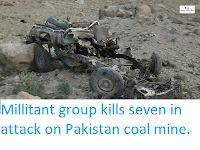An island which formed off the coast of Pakistan following a Magnitude 7.7 Earthquake in September 2013 has largely disappeared. The island, named Zalzala Koh (which means 'Earthquake Mountain' in Urdu), is thought to have been caused by a mud volcano, the result of liquids or gasses being released suddenly from rocks into
soft sediments, resulting in dramatic upwelling of mud and gas.The new island was found to be venting methane in a
number of places, leading to the conclusion that a sudden change of
pressure caused methane ice buried in the mud to thaw, causing it to
expand rapidly and raise sediment to form the new island. Frozen methane
in marine sediments is quite common, as the gas freezes at quite high
temperatures under pressure. Mud volcanoes are a fairly common
occurrence in Balochistan, though where they occur offshore, as is the
case with this one, they are often eroded away by the sea fairly
quickly.
Series of satellite images of the Pakistan Coast near the port of Gwadar in Balochistan, taken between April 2013 and April 2019, showing the appearance and disappearance of the new island. Earth Observatory/NASA.
The Earthquake which formed the island had an epicentre roughly 400 km to the north of where the island formed, was felt as far away as New Delhi and Dubai, and resulted in over 800 fatalities, mainly in the Arawan District, where many buildings collapsed (around 90% of buildings were destroyed in communities close to the epicentre).
Villagers in Labach in Arawan District forced to sleep outside
following the destruction of their homes by the 24 September 2013
Earthquake. Arshad Butt/AP.
When Zalzala Koh first emerged it was roughly 18 m high and covered an area of approximately 30 by 76 m. However, it was formed entirely of unconsolidated mud and sand, and has been slowly washed away by the waters of the Arabian Sea since this time, and is no longer visible above the surface, though the water around the site of the former island is still prone to swirling turbulence, which indicates there is still a structure close to the water surface.
Residents of Gwadar investigating the new island on 25 September 2013. Behram Balochi/AFP/Getty Images.
See also...
Follow Sciency Thoughts on Facebook.









